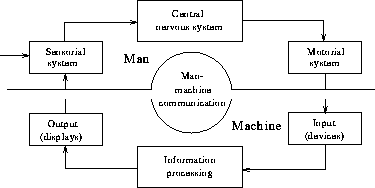



Next: Ecological interface design
Up: Architectures and
Interaction
Previous: Interactions in Virtual
In his book on man-machine communication [120], Geiser gives a good
overview on the topic. The chapters comprise theoretical aspects of
information processing and ergonomical requirements as well as technical
aspects of the computer system. The basic model of a man-machine system,
shown in figure 4.8 , is very similar to our model (compare with
figure 1.1 ).

Figure 4.8
: Structure of a
man-machine system (Taken and translated from [120])
Geiser has reviewed several different models of human-computer interaction.
A very short description of them follows:
- The layered model [246]:
- Norman has introduced a simple
conceptual model with seven different layers of user action: On top, the
user formulates a goal. In order to execute it, three layers are
needed (top-down): planning, action specification, and
action execution. To perceive feedback, another three layers are
involved (bottom-up): perception, interpretation, and
valuation of the system's state.
- The 3-level model [283]:
- Rasmussen's model
 is a conceptual model of the user, comprising three
hierarchical levels of behavior: skills, rules, and knowledge (SRK). The
layers represent different levels of abstraction in the human (cognitive)
processing system. A more detailed description of this model follows in
the next paragraph.
is a conceptual model of the user, comprising three
hierarchical levels of behavior: skills, rules, and knowledge (SRK). The
layers represent different levels of abstraction in the human (cognitive)
processing system. A more detailed description of this model follows in
the next paragraph.
- The GOMS model [60]:
- The GOMS model describes the
user's task representation as a conceptual model in terms of
Goals, Operations, Methods, and Selection rules.
It is especially useful for the prediction of the user's behavior, but it
has a major drawback: Abnormal behavior of the user is not considered.
- The keystroke-level model (KLM) [59]:
- This model only
considers one aspect of man-machine communication: How long does
it take for an experienced user to perform a standard task
without any error? The model's benefit is the quantitative measurement
of observable parameters in man-machine interactions. Drawbacks of the
KLM are that cognitive aspects are difficult to include and that in many
cases the measurements performed are not very accurate.
- The theory of cognitive complexity [156]:
- Based on the
GOMS model, Kieras and Polson have developed a theory in order to allow a
quantitative analysis of the complexity of the man-machine dialogue. The
theory's purpose is to support the design process of dialogues with
respect to the expense and the transfer of learning, the execution time,
and the user friendliness of the system. The cognitive complexity
is defined as the content, the structure, and the knowledge that the user
needs in order to use a device. Additionally, two different knowledge
representation schemes have been defined: One for the knowledge of the
user concerning the task, the other one for the device itself.
Unfortunately, the predicted results could not be proved in practice, and
the model has been refined several times by other researchers.




Next: Ecological interface design
Up: Architectures and
Interaction
Previous: Interactions in Virtual
 Esprit Project 8579/MIAMI (Schomaker et al., '95)
Esprit Project 8579/MIAMI (Schomaker et al., '95)
Thu May 18 16:00:17 MET DST 1995

